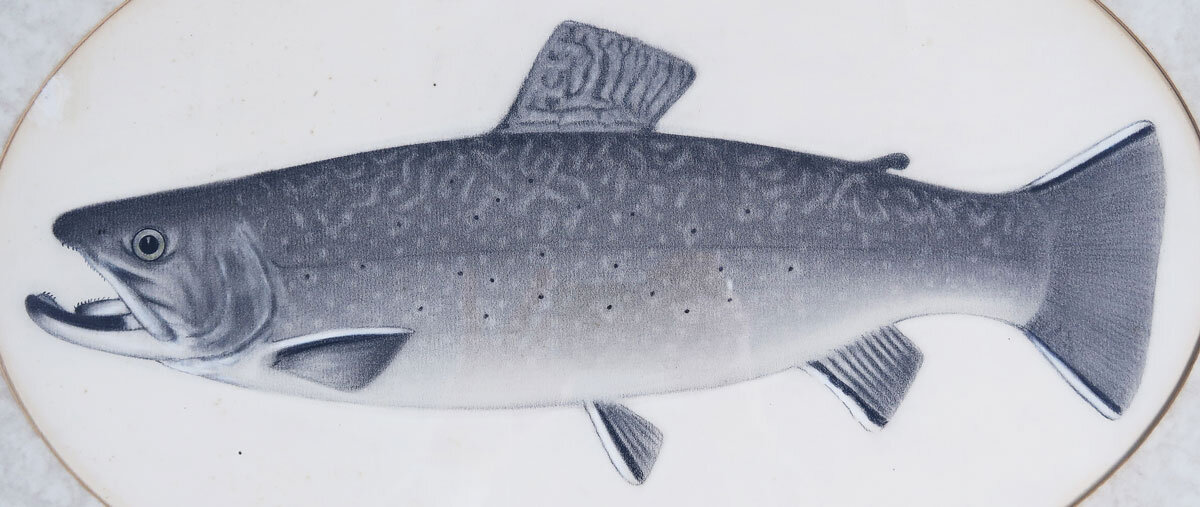Early 20th Century Portrait of a Brook Trout
Witnessing the wild beauty of a fish as it emerges on a line cast into cold, dark waters is as much an aesthetic experience as it is a sporting thrill.
(photo: onthewater.com)
Anglers who also happen to be talented artists have captured the aesthetic dimension of fishing in all forms of artistic mediums, contributing to the genre of “sporting art” which became prominent in the mid-19th century and enjoys continuing popularity today.
So as spring and summer fishing seasons beckon, we are pleased to offer for sale an early 20th century example of sporting art: an exquisitely detailed charcoal portrait of a brook trout.
The artist accurately captured all of the distinctive physical characteristics of a brook trout (Salvelinus fontinalis), making the likeness easily identifiable even in black and white:
· streamlined body and large mouth,
· wavy, wormlike markings along the dorsal surface and dorsal fin,
· a tiny adipose fin on the back directly in front of the tail,
· small spots surrounded by haloes along the sides,
· white front edges backed with a black band on the lower fins, and
· a square tail.
The trout portrait retains its original mat and molded wood frame, both of which have a marbled pattern that evokes watery swirls of light and shadows.
The frame size is 24” wide x 17.75” high and the sight size is 19.5” wide x 14” high.
Context of the Catch
But this artwork is not just an illustration of a generic brook trout—it is a drawing of a particular brook trout, presumably caught by the artist.
The caption which identifies the place where the trout was caught, “Sprain Brook,” and the specific date, “August 7th, 1907,” makes this drawing an example of a subgenre of sporting art known as fish commemoratives—artwork that illustrates a specific fish and includes written documentation about it, such as its size and weight, the name of the person who caught it, and where, when and how it was caught. (Read more about fish commemoratives in our Journal article “Three Commemorative Fish Plaques.”)
Although there is more than one Sprain Brook within the brook trout’s native range of eastern North America, we believe that this caption refers to Sprain Brook in western Connecticut, which is still listed as a major trout stream by Connecticut’s Department of Energy and Environmental Protection.
A stream passing through Washington, CT near the headwaters of Sprain Brook. Brook trout thrive in clear, cold, rapid streams where the water is well-oxygenated. (photo: hikingfordonunts.com)
While the length and weight of the brook trout were not recorded in the caption, a footnote drawing indicates how it was caught—by using a salamander as bait.
The brook trout must have been quite large to take an adult salamander, a supposition supported by the physical depiction of the captured trout as having robust girth.
. . . And What They Wore
While the fish portrait itself conveys the character of artwork that is over 100 years old, it is not straightforward to conjure the larger human context in which the art was created over of a century ago.
So here are some period photographs that make it easier to imagine how a 19th to early 20th century angler/artist might have been attired while pursuing the object of his—or her—art.
Fitz James Fitch, author of an 1884 treatise on amateur rod making, dressed and equipped for fly fishing.
Renowned angler and Maine guide Cornelia “Fly Rod” Crosby in 1894 (photo: mainememory.net)
“Old Brad” with a brook trout on Michigan’s Marquette River in 1902 as published in Field and Stream magazine.
A woman fly fishing in Nova Scotia circa 1900 (photo: troutster.com)
A Memorable Fish
Fish commemoratives such as this charcoal portrait of a brook trout become enduring records both of an angler’s pride and of a spectacular specimen of nature.
This particular artwork is a rich evocation of both nature and history, summoning an era when native brook trout were larger and more plentiful in unadulterated waterways.
The portrait makes an eloquent addition to room décor whether or not you have ever experienced the pleasure of catching a brook trout, because good art is always in season.



















